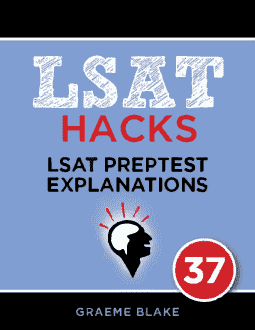This is an explanation of the first logic game from Section III of LSAT Preptest 37, the June 2002 LSAT.
A boarding school needs to assign male and female students (F, M) to occupy its dormitories. There are four dormitories: Richards, Tuscarora, Veblen, and Wisteria (R, T, V, W). Each dormitory has a North wing and a South Wing. You need to figure out students’ assignment to dormitories based on the rules.
Game Setup
This is a grouping game. We have to figure out how to arrange females and males between eight dormitories. There are five females and three males. Here’s how to set it up:

North is on the top and South is on the bottom. I’ve added in the rule that says that R and T north are filled with females.
Rules 2 and 4 are important to remember. There are only three males (rule 2). If a male is in a dormitory, then the other wing is female (rule 4).
There’s no single best way to diagram that. The main thing is to commit them to memory somehow. Here’s what I drew:

We can combine these rules to figure out that three of the four dormitories will have one male and one female, and one dormitory will be all female. This means that one of either R south or T south will be male.
Why? Well, look what happens if they’re both female:

We have no space to spread the men out across 3 dormitories. So we can draw our diagram like this to remind ourselves that at least one of them must be male.

The final rule lets us split our setup into two scenarios. It says that if males is in V south, then males are also in W north.
So we can see what happens if V south is male, and we can see what happens when it’s female.

Here I’ve made Veblen South Male. That means V north and W south are female, according to rule 4.
The other scenario is more boring. But should draw it to remind yourself that you can’t put males in V south unless your diagram follows rule 5 and looks like the diagram up above.
Drawing a way to keep yourself from forgetting the M in Vs ➞ M in W north rule.

You might think we need to put F in W north as well. But we’re not drawing the contrapositive. We’re just trying two options: males in V south (rule 5 triggered), or no males in V south (rule 5 not triggered).

Want a free Logic Games lesson?
Get a free sample of the Logic Games Mastery Seminar. Learn tips for going faster at logic games


How come in this scenario, we are not drawing the contrapositive for rule 5 unlike LSAT 34, Game 4 Setup, Doctors? I thought it you have a conditional statement you could “always” take the contrapositive, no exceptions? What is the difference between that game and rule 5 and your statement “You might think we need to put F in W north as well. But we’re not drawing the contrapositive. We’re just trying two options: males in V south (rule 5 triggered), or no males in V south (rule 5 not triggered).”
So, I said we’re not drawing the contrapositive. I didn’t say we can’t. On logic games when making scenarios you can split a conditional statement two ways:
1. A scenario where the sufficient condition happens
2. A scenario where it doesn’t happen
Then you add the rest of the rules for each scenario and get deductions.
When I did this I noticed a lot of students would instead try to use the contrapositive. But it’s inapplicable to what we’re doing.
I’m not sure that’s clear. The contrapositive is just a different way of stating the same thing. Where “the sufficient doesn’t happen” is a different statement.
So to split into two scenarios, “the sufficient happens” and “the sufficient doesn’t happen” are two different statements. Whereas “the statement” and “the contrapositive” are the same statement.